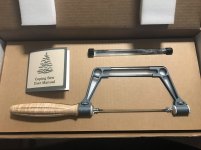Birdhunter
Member
- Joined
- Jun 16, 2012
- Messages
- 4,144
I’ve been woodworking for about 40 years and own some very nice power tools and have gotten proficient in doing highly precise work.
I’ve gotten totally engrossed in doing hand joinery. I bought a bunch of LN and Bridge City planes a long time ago, but seldom used them. A few have never encountered wood.
I just finished a Moxon vise, bought a collection of LN and Blue Spruce chisels, acquired a Bad Axe saw, experimented with router planes, and planning a shooting board.
I’m getting better with dove tails and planning some hand joinery projects.
This stuff is totally addictive.
I’ve gotten totally engrossed in doing hand joinery. I bought a bunch of LN and Bridge City planes a long time ago, but seldom used them. A few have never encountered wood.
I just finished a Moxon vise, bought a collection of LN and Blue Spruce chisels, acquired a Bad Axe saw, experimented with router planes, and planning a shooting board.
I’m getting better with dove tails and planning some hand joinery projects.
This stuff is totally addictive.


